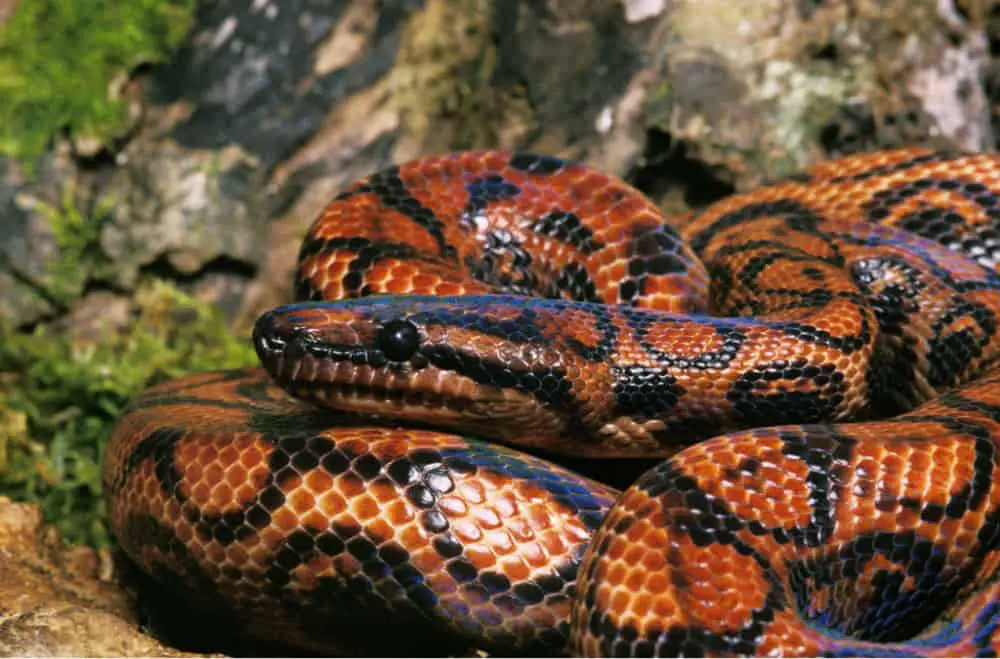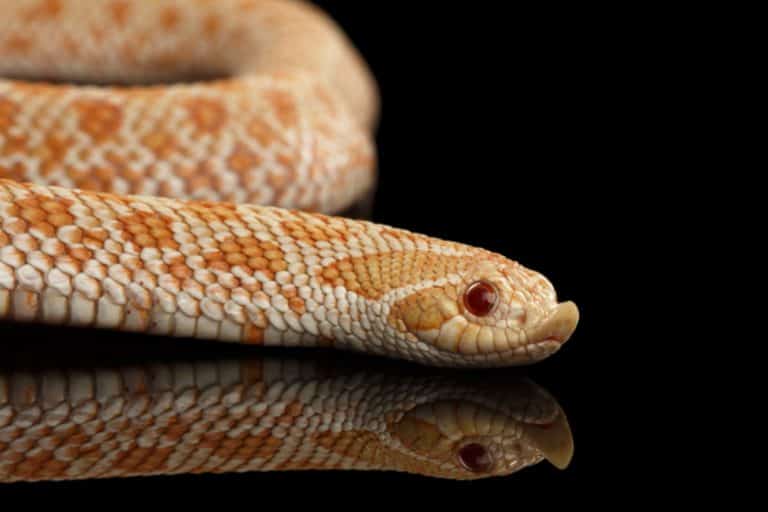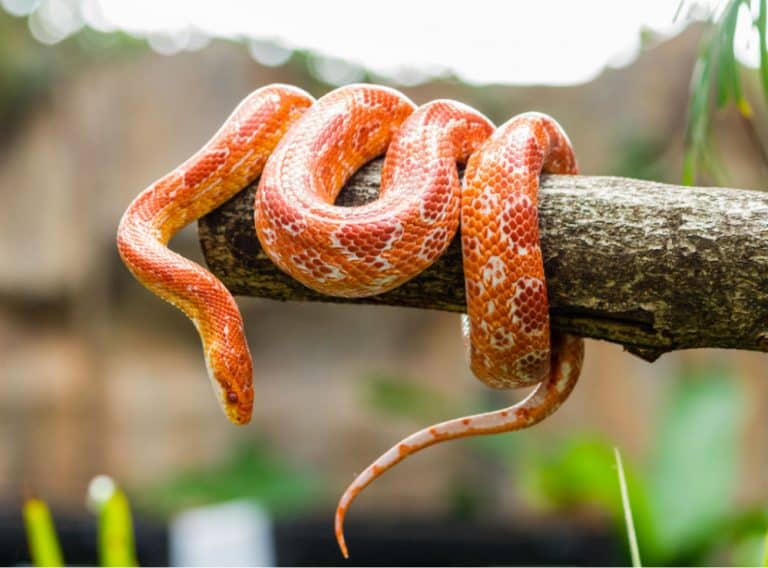Rainbow Boa Care Sheet: Diet, Habitat,& More
The Rainbow boa is arguably one of the most beautiful snakes. With an average length of 5-6 feet and slender body frames, these snakes make perfect pets for snake-lovers. So what makes the Rainbow boa one of the most sought after pet snakes?
Rainbow boas are named after their incredible iridescence caused by the microscopic ridges found on their scales. The iridescence leads to the creation of a rainbow glow when exposed to light, thus making this snake breed a sight to behold.
Interested to know more about Rainbow Boas and how to maintain them? Read on as we provide a well-detailed Rainbow Boa care sheet, discussing diet, habitat, and other important factors to observe.
Rainbow Boa Overview
The Rainbow boa is a snake species endemic to South and Central America. It is also called slender boa and has several subspecies. The most popular subspecies is the E.c. cenchria, popularly known as the Brazilian Rainbow boa.
Despite their love for living in captivity, these snakes are not big on interaction and love their personal space. You’ll find Rainbow boas on the ground or hanging on low branches in the wild, slithering away minding their business.
Breeding a Rainbow boa requires dedication and patience. These snakes love heat and high humidity levels, meaning you’ll need to recreate that rainforest feeling in his cage at home.
The Rainbow boa is not your typical large snake and will weigh an average of 4000 grams as a fully grown adult. In the wild, these snakes live for an average of 10-15 years, but at home, Rainbow boas can live for up to 20 years, provided they are properly maintained.
The Rainbow boa’s natural habitat is hot and humid rainforests, particularly the South and Central America regions. As a result, it’ll need a similar environment in its new home.
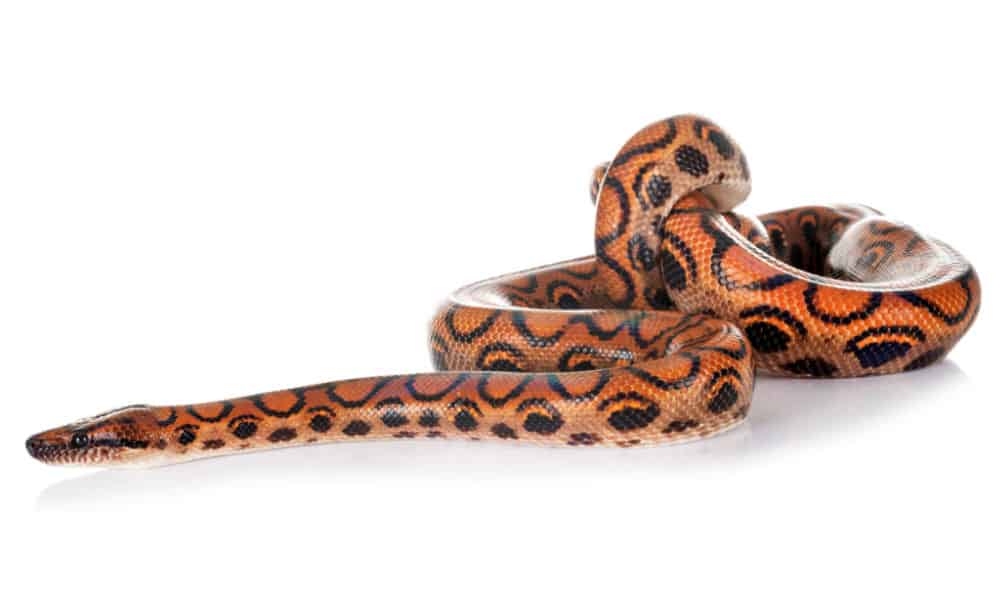
Housing Requirements for a Rainbow Boa
As naturally shy animals, Rainbow boas love their space. While they can easily fit in tight spaces, they’ll be most comfortable in large enough cages. As you’re getting a terrarium for your new Brazilian Rainbow boa, be sure it’s spacious enough to accommodate its shy character.
The ideal enclosure for Rainbow boas is 35x16x24 inches, which gives them enough space to hide, slither, and feel-in-control of their actions. Plastic or glass terrariums work well, but you can also use a blackboard base that’s well plasticized.
If dealing with baby Rainbow boas, you can settle for a tank that measures 8x6x4 inches. You can even use a moderately sized shoebox! However, over time, you’ll need to move it into a larger enclosure to accommodate his growth.
To spruce up its nest, it is advisable to throw in one or two branches or logs to allow your pet snake to rest comfortably. As you look for ways to transform his cage to Rainbow boa-friendly fortress, be sure to give it enough hiding spaces.
Heating and Lighting Requirements for Rainbow Boas
You’ll need to be extra careful when handling a Rainbow boa’s heating and lighting. The warmer side of the tank should be between 86-90 ℉ (26-32°C) while the cooler side should be around 75 ℉ (23°C). The Brazilian Rainbow Boa is usually sensitive to higher temperatures compared to the Colombian Rainbow boa.
Using a thermostat to regulate temperatures within the cage is advisable. A highly-rated thermostat like the BN-Link Digital Heat Thermostat will help in regulating temperatures within the snake tank.
Rainbow boas aren’t usually big on basking, meaning you won’t need to set up high-wattage spotlights on the hot side. However, since these snakes are used to naturally hot climates, you should ensure the heat levels are high enough to suit the boa’s unique preferences.
It is highly advisable to maintain a thermal gradient in the snake tank. Using overhead lighting and snake heat lamps like the Zacro Reptile Heat Lamp will help maintain an ideal thermal gradient for the Rainbow boa, making the environment optimum for his day to day activities. You can also use the iPower Reptile Heat Pad to distribute the heat uniformly across your Rainbow Boa’s base area.
Rainbow boas are naturally nocturnal, meaning you’ll need to manage the lighting system well enough. You can mount a low wattage light inside the tank to accentuate your boa’s beauty and bring out the lively rainbow colors when he slithers around his cage.
Rainbow boas thrive in highly humid environments. Unfortunately, the humidity levels inside homes are nowhere near the minimum requirements for Rainbow boas, meaning you’ll need to improvise. Misting your snake’s enclosure daily is highly recommended, more so since he needs an average humidity level of 75-90% at all times.
Ideal Substrates for Rainbow Boas
Rainbow boas thrive on snake beddings that resemble the Amazon rainforest. That is, the floor should be moist enough but tough nonetheless. You should choose bedding that’s easy to clean and absorbs enough moisture. The Fulker Labs Repta-Bark is an example of a top-drawer bedding ideal for humidity-loving pets like the Rainbow Boa.
You can also use wood shavings if you’re looking for an affordable option. Point to note, though, wood shavings are usually hard to clean, meaning they won’t work well, especially since Rainbow boas love their privacy!
Newspapers and paper towels also work as ideal bedding for Rainbow boas (especially babies). They are easy to clean and can be removed without disturbing your peaceful boa.
As you plan the bedding cleaning routine, make sure you space the cleaning sessions well enough, maybe around once a month. Boas don’t love extra attention, meaning you should clean as fast as possible to avoid stressing your pet snake.
If you want an aesthetically appealing terrarium, you can opt for green moss and sphagnum to provide additional moisture while maintaining humidity. Beddings like Terrarium Moss by Zoo Med are ideal for recreating that natural rainforest feeling that your boa will love.
Disclaimer, you should avoid using redwood and cedar shavings as they contain chemical toxins that are potentially harmful to snakes.
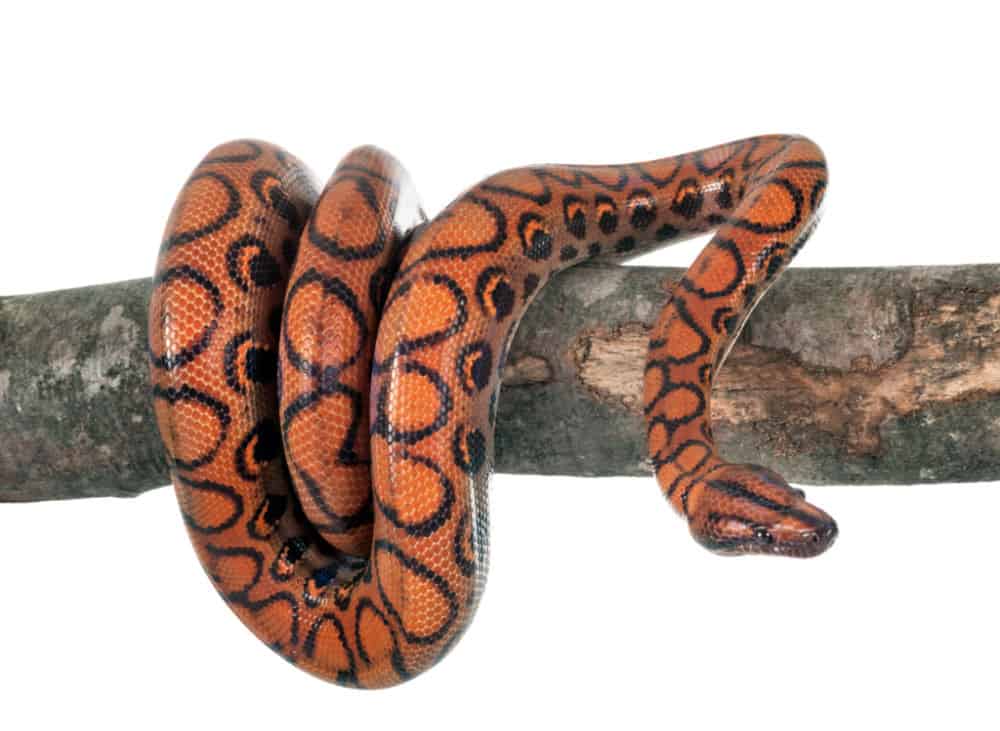
What Should I Feed My Rainbow Boa?
Similar to all boas in the Boidae family, Rainbow boas are non-venomous and subdue all prey through constriction. Rainbow boas will eat birds, fowl, and small animals like rodents and bats when out in the wild. Through their long, sharp fangs, Rainbow boas pierce their prey, setting the stage for strangulation.
In captivity, these snakes don’t fuss much about what they eat. They eat about once a week and will appreciate dining on birds or rats. It is best to give your boa freshly killed or thawed food items. Feeding your pet snake live animals can lead to injuries such as rodent bites.
Thawing frozen food comes with two main benefits. First, warming the food reduces the chances of shocking your snake’s digestive system. Secondly, snakes love thawed food as they usually give the illusion of a live prey item.
You’ll have to be careful when feeding baby Rainbow boas. These tiny snakes will thrive on pinky mice, approximately 3-8 days after birth, but as they continue to grow, they’ll need a switch to larger prey.
You should always feed your snake a meal that’s as wide as his or her largest point. Anything larger than that can lead to health complications such as obesity.
Female Rainbow boas have better digestion systems, allowing you to experiment more on rats, mice, and other rodents. Male Rainbow boas thrive on mice, which are easier for them to digest. You won’t need to adjust or attempt to balance your boa’s diet as these snakes can feed exclusively on rodents, and still maintain perfect health.
As you check on your boa after mealtimes, be sure to spot clean the leftovers to ensure the environment remains conducive enough to his liking! Rainbow boas are most active during the night, so you should check for leftovers in the morning.
Rainbow Boa Water Requirements
You’ll also need to keep a keen eye on the water you give your Rainbow boa. These snakes need proper hydration, meaning they should always have a shallow bowl of water in their tanks. Therefore, the best water bowl for Rainbow boas should be shallow but wide enough to accommodate your boa’s size.
The ideal snake tub for a Rainbow boa should measure around 13 inches long x 13 inches wide x 7 inches tall. But you should avoid filling the tub to prevent spilling, which tends to occur when the boa displaces his weight on the water when soaking.
To know if your snake is dehydrated or affected by overheating, check for signs such as wrinkly (and dry) scales, regurgitation, and incomplete shades. Ensure that the water is changed frequently, at least once a week, to keep the tank clean.
Can you give a Rainbow boa water untreated tap water? Yes, most herpetoculture experts will agree that tap water is okay for snakes. Reptiles can comfortably consume hard water containing magnesium and calcium without developing any health complications. However, you’ll want to make sure the tap water is clean enough for your snake’s consumption.
Common Rainbow Boa Health Issues
You’ll be glad to learn that Rainbow boas thrive in captivity. This means that with the right husbandry, your little snake pet will live long enough to see your children move out.
With Rainbow boas, most of their health issues arise when exposed to low-humidity environments. As humidity-loving reptiles, these snakes need tanks that can retain enough humidity. Misting the snake tank daily will help maintain good humidity levels. You should also change the water regularly.
Rainbow boas tend to gain or lose weight easily. As a result, owners are advised to feed appropriately-sized rodents. Giving your adult Rainbow boa a tiny mouse for its weekly meal might leave him emaciated. Also, overfeeding him might lead to obesity, which results in further complications and reduced life-span.
As is common with most snakes in the Boidae family, Rainbow boas tend to experience dystocia when giving birth. Dystocia refers to birth-related complications, more specifically, when babies are wrongly positioned. Such conditions might require surgery to save both the mother and the child.
How to Know if a Rainbow Boa Is Healthy or Unhealthy
Normal Feeding: A healthy Rainbow boa will feed normally and consume his rodents as per the usual quantity. These snakes tend to feed at night.
Hiding: As solitary snakes, you should expect your Rainbow boa to curl away and make the most of his hiding spaces.
Shy and Fearful: Rainbow boas aren’t naturally aggressive and tend to avoid interaction as much as possible. You should be worried if your boa doesn’t struggle to resist handling when you take him outside his tank.
Obesity and Emaciation: Be keen to observe the weight patterns of your Rainbow Boa. Obesity and emaciation are signs of poor health.
Regurgitation: Be keen on whether your snake regurgitates his food. If he does this twice or thrice, you’ll need to see a vet for further advice.
Dry Eyes: Pitting or denting of the eye cap is common in Rainbow boas, especially due to their need for highly humid conditions. If you see your snake with dry eyes, chances are you’ll need to increase his water supply or increase the misting frequency in its tank.
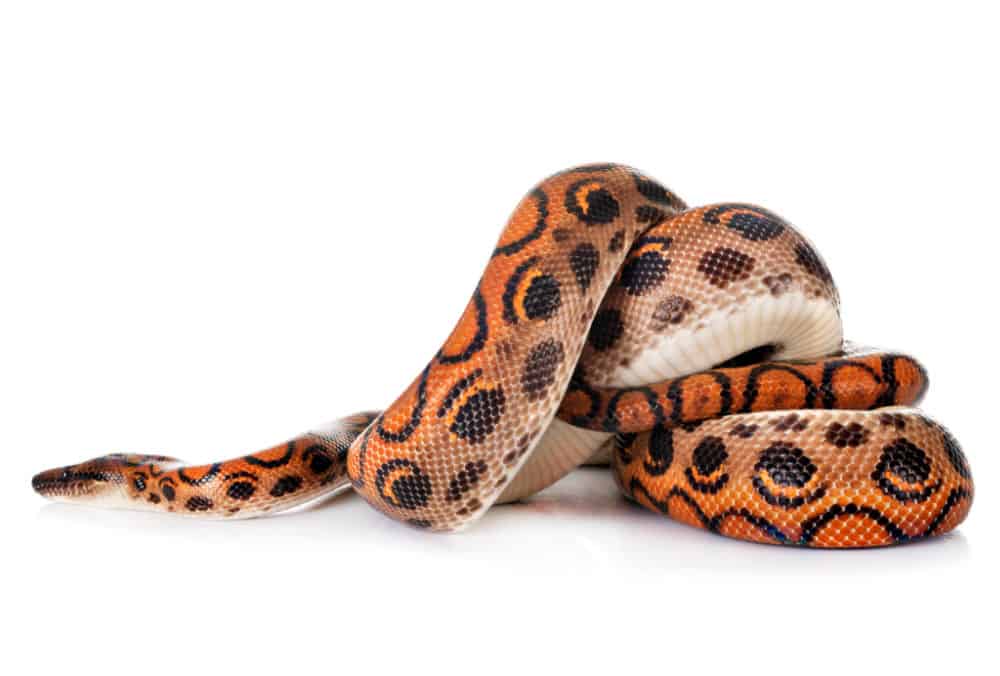
Rainbow Boa Temperament and Handling
As fairly docile pets, these snakes won’t mind regular handling (provided handling isn’t overdone). Baby Rainbow Boas, however, loathe being handled, but they’ll get used over time.
Since Rainbow boas are loner snakes, it is advisable to minimize handling them. Sure, they aren’t venomous, but they can give a good bite when irritated. As a result, it is advisable to handle them with thick leather gloves, especially if you’re a first-timer.
When moving the snake, always support his full body weight. He will be uncomfortable and easily irritable if you leave him hanging. Also, due to their extra-long fangs, holding Rainbow boas behind their tiny heads is recommended.
When you bring a new Rainbow boa home, be sure to give him ample time to settle down and get used to the new environment. He’ll probably hide away for a couple of hours (or even days) and resurface when he’s fully comfortable.
Disclaimer, you should avoid handling your Rainbow boa for a day or two after feeding. These snakes love their space and can be extra irritable during the first hours of digestion. If you have to clean up, do so quickly without touching the snake as you’ll only stress it out.
Cleaning a Rainbow Boa’s Snake Tank
Breeding a Rainbow boa isn’t easy, but managing to keep your pet snake healthy is truly fulfilling. Always mist its tank. Daily misting is highly recommended, especially if your home tends to have dry air.
You should also spot clean the terrarium daily, as it’ll help keep the tank clean and conducive enough for your pet snake. While it’s advisable to spot clean daily, deep cleaning should be fairly infrequent, approximately once a month.
When deep cleaning, consider changing the substrate, switching to new materials if necessary. But deep cleaning will probably leave your Rainbow Boa uncomfortable, exactly why you should do it as quickly as possible.
A newspaper substrate allows for smooth and easy cleanups. But with substrates like wood shavings, you’ll need a bit more time to get the job done!
As you’re cleaning up the tanks, expect to run into brown feces. Occasionally, you might find undigested parts such as fur.
Do Rainbow Boas Make Good Pets?
These snakes thrive on captivity, which means they’ll easily get used to their new homes provided it suits their preferences.
As is required when buying other pets, ensure you deal with a trusted snake breeder. If incorrectly bred, your Rainbow boa might spend more time on the treatment table than in his tank.
Despite their shy attributes, Rainbow boas love to be in control of their movements. As a result, you should get your snake a hide (preferably two) to ensure he can hide away when he wants.
The best idea is to place one hide in the warm end and another at the tank’s cooler end.
You can also add pieces of wood and rocks to your Rainbow boa’s cage. Hard surfaces will come in handy when the snake is shedding. However, you should be careful when setting up these additional items to ensure they don’t introduce parasites or crush your Rainbow boa.
Final Takeaway
The Rainbow boa is truly a ray of sunshine for any snake enthusiast. Its distinctive stripes and highly iridescent scales make the snake aesthetically appealing, and arguably one of the most beautiful snakes to own.
Although not the most demanding snake species in terms of husbandry, you’ll need to take extra caution when it comes to temperature and moisture regulation. Rainbow boas thrive in hot and high-humidity areas, meaning you’ll have to regulate the moisture and temperature levels in his cage.
As a solitary animal, your Rainbow boa will be more than happy to be left alone. So it is completely normal to see it resist and act shy when being handled.

